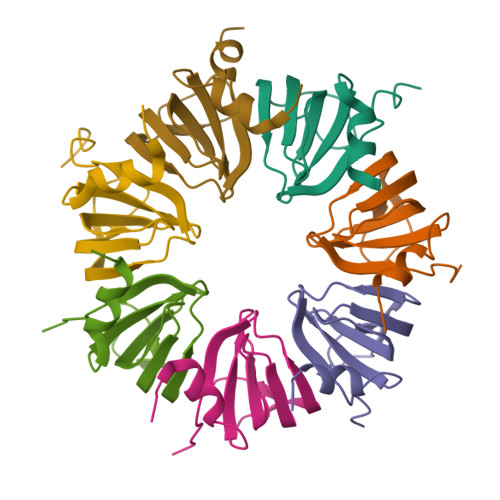The Heptameric SmAP1 and SmAP2 Proteins of the Crenarchaeon Sulfolobus Solfataricus Bind to Common and Distinct RNA Targets.
Martens, B., Bezerra, G.A., Kreuter, M.J., Grishkovskaya, I., Manica, A., Arkhipova, V., Djinovic-Carugo, K., Blasi, U.(2015) Life (Basel) 5: 1264-1281
- PubMed: 25905548
- DOI: https://doi.org/10.3390/life5021264
- Primary Citation of Related Structures:
4XQ3 - PubMed Abstract:
Sm and Sm-like proteins represent an evolutionarily conserved family with key roles in RNA metabolism. Sm-based regulation is diverse and can range in scope from eukaryotic mRNA splicing to bacterial quorum sensing, with at least one step in these processes being mediated by an RNA-associated molecular assembly built on Sm proteins. Despite the availability of several 3D-structures of Sm-like archaeal proteins (SmAPs), their function has remained elusive. The aim of this study was to shed light on the function of SmAP1 and SmAP2 of the crenarchaeon Sulfolobus solfataricus (Sso). Using co-purification followed by RNASeq different classes of non-coding RNAs and mRNAs were identified that co-purified either with both paralogues or solely with Sso-SmAP1 or Sso-SmAP2. The large number of associated intron-containing tRNAs and tRNA/rRNA modifying RNAs may suggest a role of the two Sso-SmAPs in tRNA/rRNA processing. Moreover, the 3D structure of Sso-SmAP2 was elucidated. Like Sso-SmAP1, Sso-SmAP2 forms homoheptamers. The binding of both proteins to distinct RNA substrates is discussed in terms of surface conservation, structural differences in the RNA binding sites and differences in the electrostatic surface potential of the two Sso-SmAP proteins. Taken together, this study may hint to common and different functions of both Sso-SmAPs in Sso RNA metabolism.
Organizational Affiliation:
Department of Microbiology, Immunobiology & Genetics, Max F. Perutz Laboratories, University of Vienna, Vienna Biocenter, Dr. Bohrgasse 9, 1030 Vienna, Austria. Birgit.maertens@univie.ac.at.
















